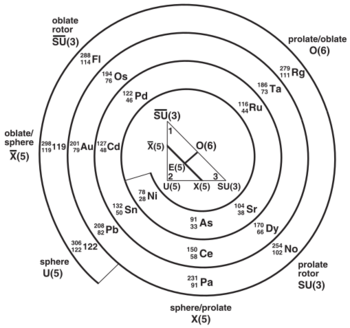Physics:Interacting boson model
| Nuclear physics |
|---|
 |
| Nucleus · Nucleons (p, n) · Nuclear matter · Nuclear force · Nuclear structure · Nuclear reaction |
The interacting boson model (IBM) is a model in nuclear physics in which nucleons (protons or neutrons) pair up, essentially acting as a single particle with boson properties, with integral spin of either 2 (d-boson) or 0 (s-boson). They correspond to a quintuplet and singlet, i.e. 6 states.
It is sometimes known as the Interacting boson approximation (IBA).[1]:7
The IBM1/IBM-I model treats both types of nucleons the same and considers only pairs of nucleons coupled to total angular momentum 0 and 2, called respectively, s and d bosons.
The IBM2/IBM-II model treats protons and neutrons separately.
Both models are restricted to nuclei with even numbers of protons and neutrons.[1]:9

The model can be used to predict vibrational and rotational modes of non-spherical nuclei.[2]
History
This model was invented by Akito Arima and Francesco Iachello in 1974.[1]:6 while working at the Kernfysisch Versneller Instituut(KVI) in Groningen, Netherlands. KVI is now property of Universitair Medisch Centrum Groningen (https://umcgresearch.org/).
See also
- Liquid drop model
- Nuclear shell model
References
- Arima, A.; Iachello, F. (1975-10-20). "Collective Nuclear States as Representations of a SU(6) Group". Physical Review Letters (American Physical Society (APS)) 35 (16): 1069–1072. doi:10.1103/physrevlett.35.1069. ISSN 0031-9007. Bibcode: 1975PhRvL..35.1069A.
- Iachello, F; Arima, A. (1987). The Interacting Boson Model. Cambridge: Cambridge University Press. ISBN 978-0-511-89551-7. OCLC 776970502.
- Arima, A; Iachello, F (1976). "Interacting boson model of collective states I. The vibrational limit". Annals of Physics (Elsevier BV) 99 (2): 253–317. doi:10.1016/0003-4916(76)90097-x. ISSN 0003-4916. Bibcode: 1976AnPhy..99..253A.
- Arima, A; Iachello, F (1978). "Interacting boson model of collective nuclear states II. The rotational limit". Annals of Physics (Elsevier BV) 111 (1): 201–238. doi:10.1016/0003-4916(78)90228-2. ISSN 0003-4916. Bibcode: 1978AnPhy.111..201A.
- Scholten, O; Iachello, F; Arima, A (1978). "Interacting boson model of collective nuclear states III. The transition from SU(5) to SU(3)". Annals of Physics (Elsevier BV) 115 (2): 325–366. doi:10.1016/0003-4916(78)90159-8. ISSN 0003-4916. Bibcode: 1978AnPhy.115..325S.
- Arima, A; Iachello, F (1979). "Interacting boson model of collective nuclear states IV. The O(6) limit". Annals of Physics (Elsevier BV) 123 (2): 468–492. doi:10.1016/0003-4916(79)90347-6. ISSN 0003-4916. Bibcode: 1979AnPhy.123..468A.
- Arima, A; Iachello, F (1981). "The Interacting Boson Model". Annual Review of Nuclear and Particle Science (Annual Reviews) 31 (1): 75–105. doi:10.1146/annurev.ns.31.120181.000451. ISSN 0163-8998. Bibcode: 1981ARNPS..31...75A.
- Talmi, Igal (1993). Simple models of complex nuclei : the shell model and interacting boson model. Chur, Switzerland Langhorne, Pa., U.S.A: Harwood Academic Publishers. ISBN 978-3-7186-0550-7. OCLC 25706648.
- ↑ 1.0 1.1 1.2 Walter Pfeifer (1998). An Introduction to the Interacting Boson Model of the Atomic Nucleus. ISBN 978-3-7281-2520-0. https://arxiv.org/ftp/nucl-th/papers/0209/0209039.pdf.
- ↑ 2.0 2.1 Kratz, J. V. (5 September 2011). "The Impact of Superheavy Elements on the Chemical and Physical Sciences". 4th International Conference on the Chemistry and Physics of the Transactinide Elements. http://tan11.jinr.ru/pdf/06_Sep/S_1/02_Kratz.pdf. Retrieved 27 August 2013.
Further reading
 |

